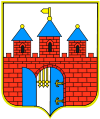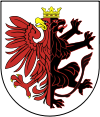Bydgoszcz
| Bydgoszcz | |||
 |
|||
|
|||
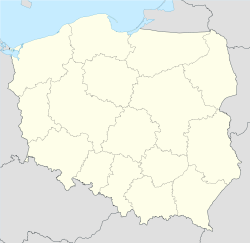 Bydgoszcz
|
|||
| Coordinates: | |||
| Country | |||
|---|---|---|---|
| Voivodeship | Kuyavian-Pomeranian | ||
| County | city county | ||
| Established | before 1238 | ||
| Town rights | 1346/1349 | ||
| Government | |||
| - President (Mayor) | Konstanty Dombrowicz | ||
| Area | |||
| - City | 175 km² (67.6 sq mi) | ||
| Elevation | 60 m (197 ft) | ||
| Population (2006) | |||
| - City | 364,953 | ||
| - Density | 2,085.4/km² (5,401.3/sq mi) | ||
| - Metro | 460,499 | ||
| Time zone | CET (UTC+1) | ||
| - Summer (DST) | CEST (UTC+2) | ||
| Postal code | 85-001 to 85-915 | ||
| Area code(s) | +48 52 | ||
| Car plates | CB | ||
| Website: http://www.bydgoszcz.pl/ | |||
Bydgoszcz [ˈbɨdgɔʂt͡ʂ] (![]() listen) (German: Bromberg (
listen) (German: Bromberg (![]() listen), Latin: Bydgostia) is a city in northern Poland, on the Brda and Vistula rivers, with a population of 369,151 (2004), agglomeration more than 400 000, which makes it the 8th biggest city in Poland. It has been the co-capital with Toruń of the Kuyavian-Pomeranian Voivodeship since 1999, and was previously the capital of the Bydgoszcz Voivodeship (1947-1998) and before that, of the Pomeranian Voivodeship (1945-1947). Since 1999 it is also the seat of Bydgoszcz County.
listen), Latin: Bydgostia) is a city in northern Poland, on the Brda and Vistula rivers, with a population of 369,151 (2004), agglomeration more than 400 000, which makes it the 8th biggest city in Poland. It has been the co-capital with Toruń of the Kuyavian-Pomeranian Voivodeship since 1999, and was previously the capital of the Bydgoszcz Voivodeship (1947-1998) and before that, of the Pomeranian Voivodeship (1945-1947). Since 1999 it is also the seat of Bydgoszcz County.
Bydgoszcz is part of the metroplex Bydgoszcz-Toruń with Toruń, only 45 km away, and over 850,000 inhabitants. Bydgoszcz is the seat of Casimir the Great University, University of Technology and Life Sciences and a conservatory as well as a Collegium Medicum of Nicolaus Copernicus University in Toruń. Bydgoszcz has a famous Concert Hall (Filharmonia Pomorska), opera house Opera Nova, From the Bydgoszcz Ignacy Jan Paderewski Airport there are flights to Warsaw, London, Dublin, Liverpool, Berlin, Katowice, Vienna, Copenhagen, Birmingham and Düsseldorf-Weeze as well charter flights to Antalya, Crete and Tunis. Thanks to its location between Vistula and Odra water system on the Bydgoszcz channel, the city is an important link in a water system connected via Noteć, Warta, Odra, Elbe with the Rhine and Rotterdam.
Contents |
History
Originally a fishing settlement called Bydgozcya ("Bydgostia" in Latin), the city became a stronghold for the Vistula trade routes. In the 13th century it was the site of a castellany, first mentioned in 1238. The city was occupied by the Teutonic Knights from 1331–1337, and later by King Casimir III of Poland, who granted the city municipal rights on 19 April 1346. The city increasingly saw an influx of Jews after that date.
In the 15th-16th centuries Bydgoszcz was a significant site for corn trading. The Treaty of Bydgoszcz was signed in the city in 1657.
Bydgoszcz followed the history of Greater Poland until 1772, when it was annexed by the Kingdom of Prussia in the First Partition of Poland and incorporated into the Netze District and, later, West Prussia. During this time, a canal was built from Bydgoszcz to Nakło which connected the north-flowing Vistula River via the Brda to the west-flowing Noteć, which in turn flowed to the Oder via the Warta.
In 1807 Bydgoszcz became part of the Duchy of Warsaw. In 1815 it returned to Prussian rule as part of the autonomous Grand Duchy of Poznań (the Province of Posen after 1848) and the capital of the Bromberg region. After 1871 the city was part of the German Empire. After World War I and the Great Poland Uprising, Bydgoszcz was annexed to Poland in 1919. It shifted in 1938 to the Pomeranian Voivodeship.
From 1939-45 during World War II, Bydgoszcz was overrun by Nazi Germany and annexed to the Reichsgau Wartheland. On September 3 1939, shortly after the war started, the Bromberg Bloody Sunday incident occurred in which numerous Poles and Germans were killed; the incident was used by Nazi propaganda for retaliation against Poles after Bydgoszcz was occupied by the Wehrmacht on September 9. The city's Jewish citizens were repressed, as thousands of people were sent to concentration camps and/or executed. Bydgoszcz was the site of Bromberg-Ost, a female subcamp of Stutthof. The subcamp staffed several female SS guards (Aufseherin) and was commanded by the Oberaufseherin Johanna Wisotzki and a male commandant. A deportation camp was situated in Smukała village, now part of Bydgoszcz. According to Nowa encyklopedia powszechna PWN, 37,000 citizens of the city died during the war.[1]
In 1945 Bydgoszcz was liberated and annexed again to Poland.
In 1981 Solidarity's activists were violently suppressed in Bydgoszcz.
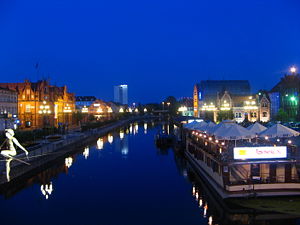
Economy
Major corporations
- Projprzem SA
- Zachem SA Ciech Chemical Group
- Zespół Elektrociepłowni Bydgoszcz SA
- PESA Pojazdy Szynowe (PESA Rail Vehicles)
- GCB Centrostal-Bydgoszcz S.A.
- Bipromasz - Biuro Projektowo - Handlowe
- Przedsiębiorstwo Innowacyjno-Wdrożeniowe "Wamet" Sp. z o.o.
Education

- Kazimierz Wielki University
- Uniwersytet Technologiczno Przyrodniczy im. Jana i Jędrzeja Śniadeckich
- Akademia Muzyczna
- University Collegium Medicum im. Ludwika Rydygiera (Uniwersytet Mikołaja Kopernika w Toruniu, Akademia Medyczna)
- Ośrodek Akademii Ekonomicznej w Poznaniu
- Sekcja Wydziału Teologicznego Uniwersytetu im. A. Mickiewicza w Poznaniu
- Kujawsko-Pomorska Szkoła Wyższa
- Wyższa Szkoła Gospodarki
- Wyższa Szkoła Informatyki i Nauk Społeczno-Prawnych
- Wyższa Szkoła Środowiska
- Wyższa Szkoła Zarządzania i Finansów
- Wyższa Szkoła Informatyki in Łódź, Branch in Bydgoszcz
- Nauczycielskie Kolegium Języków Obcych
- Niepubliczne Nauczycielskie Kolegium Języków Obcych
Transport

Airports
- Bydgoszcz Ignacy Jan Paderewski Airport
Railways
Bydgoszcz is one of the biggest railroad junctions in Poland, with two important lines crossing there - the east-west connection from Toruń to Pila and the north-south line from Inowrocław to Gdańsk (see: Polish Coal Trunk-Line). There are also secondary-importance lines stemming from the city, to Szubin and to Chełmża.
Among rail stations located in the city, there are:
- Bydgoszcz Główna - main railway station
- Bydgoszcz Leśna
- Bydgoszcz Wschód
- Bydgoszcz Zachód
- Bydgoszcz Łęgnowo
- Bydgoszcz Bielawy
- Bydgoszcz Osowa Góra
Bus stations
- PKS Bydgoszcz - operates inter-city and international bus routes
Culture
Museums
- Muzeum Okręgowe im. Leona Wyczółkowskiego (Leon Wyczółkowski District Museum) is a municipally-owned museum. Apart from a large collection of Leon Wyczółkowski's works, it houses permanent as well as temporary exhibitions of art.
It occupies several buildings: - Main building (Gdańska 4 St.) - The White Granary (Mennica St.)
Classical music
- Filharmonia Pomorska im. Ignacego Paderewskiego (Ignacy Paderewski's Concert Hall) - thanks to superbly designed acoustic qualities of the main concert hall, it is one of the best classical music concert halls in Europe.
Popular music
- Concerts of popular music in Bydgoszcz are usually held in Filharmonia Pomorska, Łuczniczka, Zawisza and Polonia stadiums as well as open plains of Myslecinek's Rozopole on the outskirts of the city.
Alternative music festival "Low Fi" http://www.lowfi-festival.com
Theatre

- Teatr Polski im. Hieronima Konieczki (Hieronim Konieczka's Polish Theatre) - despite its name, theatre offers a wide variety of shows both of national and foreign origin. It also regularly plays hosts to a large number of touring shows. Once a year, in autumn, "Festiwal Prapremier" is organized: the most renowned Polish theatres stage their latest premieres.
- Opera Nova (The Nova Opera)
Sports
Sports clubs
- Astoria Bydgoszcz - men's basketball team playing in Dominet Bank Ekstraliga (formerly Era Basket Liga): 8th in 2003/2004 season, 6th in 2004/2005, 9th in 2005/2006. In 2006, due to lack of funding, the team was relegated to 3rd Polish League, now play in 2nd Polish League.
- Centrostal Focus Park Bydgoszcz - women's volleyball team playing in Polish Seria A Women's Volleyball League: 2nd place in 2004/2005 season, 4th place in 2005/2006 season.
- Delecta Chemik Bydgoszcz - men's volleyball team playing in Polish Volleyball League
- Polonia Bydgoszcz - speedway team from the Polish 1st League. The club has won Polish Speedway League 7 times (lately in 2002) and European Team Championship 3 times (lately in 2001).
- Zawisza Bydgoszcz - football (soccer) team playing in Polish 2nd League.
Sports facilities

- Łuczniczka Sports Centre
- Zdzisław Krzyszkowiak Stadium
- Polonia Stadium
Sports events
- Speedway:
- Grand Prix of Poland: (1998-1999, since 2001)
- Grand Prix of Europe: (2000)
- Mieczysław Połukard Criterium of Polish Speedway Leagues Aces (1951-1960, since 1982)
- Bydgoszcz will be the host of the IAAF 2008 World Junior Championships in Athletics
Politics
Bydgoszcz constituency
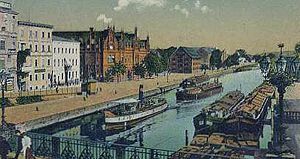
Members of Polish Sejm 2007-2011 elected from Bydgoszcz constituency:
- Anna Bańkowska, Left and Democrats
- Krzysztof Brejza, Civic Platform
- Jarosław Katulski, Civic Platform
- Eugeniusz Kłopotek, Polish People's Party
- Tomasz Latos, Law and Justice
- Wojciech Mojzesowicz, Law and Justice
- Paweł Olszewski, Civic Platform
- Teresa Piotrowska, Civic Platform
- Grzegorz Roszak, Civic Platform
- Radek Sikorski, Civic Platform
- Andrzej Walkowiak, Law and Justice
- Janusz Zemke, Left and Democrats
Members of Polish Senate 2007-2011 elected from Bydgoszcz constituency:
- Zbigniew Pawłowicz, Civic Platform
- Jan Rulewski, Civic Platform
People
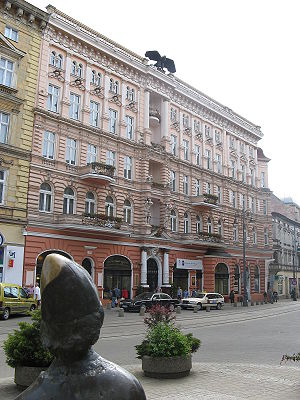
- Jan Krzysztof Bielecki (born 1951), Prime Minister of the Republic of Poland
- Zbigniew Boniek (born 1956), football player
- Stefan Majewski (born 1956), football player
- Mieczysław Garsztka (1896-1919), aviator
- Jacek Gollob (born 1969), speedway rider
- Tomasz Gollob (born 1971), speedway rider
- Hugo Hergesell (1859-1938), meteorologist
- Marcin Jaskulski, journalist
- Jan Kulczyk (born 1950), businessman
- Walter Leistikow (1865-1908), painter
- Wojciech Łobodziński (born 1982), footballer
- Eberhard von Mackensen (1889-1969), general
- Paweł Olszewski (born 1979), politician
- Edmund Michał Piszcz (born 1929), archbishop
- Katarzyna Radtke (born 1969), race walker
- Marian Rejewski (1905-1980), cryptologist
- Morris D. Rosenbaum (1831-1885), businessman
- Jan Rulewski (born 1944), politician
- Vivian Schmitt (born 1978), pornographic actress
- Radosław Sikorski (born 1963), Minister of Foreign Affairs of the Republic of Poland
- Grażyna Szapołowska (born 1953), film actress
- Kurt Tank (1898-1983), aerospace engineer
- Janusz Turowski (born 1961), football coach
- Filip Zadruzynski (* 1988), Kickbox
Legends
It is also said that Pan Twardowski spent some time in the city of Bydgoszcz, where, in his memory, a figure was recently mounted in a window of a tenement, overseeing the Old Town. At 1:13 p.m. and 9:13 p.m. the window opens and Pan Twardowski appears, to the accompaniment of weird music and devilish laughter. He takes a bow, waves his hand, and then disappears. This little show gathers crowds of amused spectators.
Twin Towns - Sister Cities
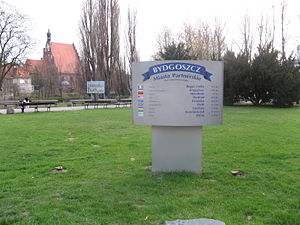
Bydgoszcz is twinned with:
|
|
See also
- Bromberg-Ost, a female subcamp of the German concentration camp Stutthof, located in Bydgoszcz.
- Bydgoszcz Department (Polish: Departament Bydgoski), a unit of administrative division and local government in the Duchy of Warsaw from 1806-1815.
- Roman Catholic Diocese of Bydgoszcz
References
- ↑ "Kragujevac City Partners". © 2008 Information service of Kragujevac City. Retrieved on 2008-10-27.
External links
- (English) Municipal website
- (Polish) Wirtualna Bydgoszcz - informator bydgoski
- (Polish) Bydgoszcz news
- (Polish) Canal Bydgoski
- (English) Evangelical - Augsburg (Lutheran) Parish in Bydgoszcz
|
|||||||
|
||||||||||
|
|||||||

